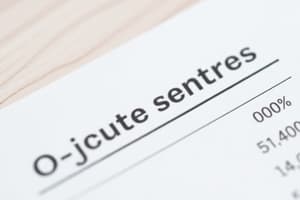Podcast
Questions and Answers
Which account is considered a permanent account?
Which account is considered a permanent account?
What is the purpose of closing entries?
What is the purpose of closing entries?
What happens if all balance sheet accounts have zero balances due to closing entries?
What happens if all balance sheet accounts have zero balances due to closing entries?
What is an example of a temporary account that will be closed at the end of the accounting period?
What is an example of a temporary account that will be closed at the end of the accounting period?
Signup and view all the answers
Which step in the accounting cycle is typically not performed daily?
Which step in the accounting cycle is typically not performed daily?
Signup and view all the answers
How is the current ratio calculated?
How is the current ratio calculated?
Signup and view all the answers
How are current assets typically listed on a classified balance sheet?
How are current assets typically listed on a classified balance sheet?
Signup and view all the answers
What will be affected by a reclassification of liabilities from current to non-current?
What will be affected by a reclassification of liabilities from current to non-current?
Signup and view all the answers
Study Notes
Closing Entries
- Transfer profit or loss and Owner's Drawings to the Owner's Capital account.
- Occur after financial statements are prepared.
- Result in zero balances for all balance sheet accounts if done correctly.
- An error in closing entries can overstate assets and revenue.
Owner's Capital Account
- A permanent account.
Temporary Accounts
- Examples include Service Revenue.
- Closed to Income Summary at the end of the accounting period.
Accounting Cycle
- Involves analyzing transactions as the first step.
- Preparing adjusting entries is generally not done daily.
- Preparing a post-closing trial balance is the final step.
Balance Sheet
- Current assets are listed in order of liquidity.
- Office equipment is classified as property, plant, and equipment.
- Current assets are expected to be converted to cash, sold, or consumed within one year.
- Intangible assets derive value from their rights and privileges.
- Liabilities are classified as current and non-current.
Liquidity
- The relationship between current assets and current liabilities is important for evaluating a company's liquidity.
- The current ratio is calculated by dividing current assets by current liabilities.
- Reclassifying liabilities from current to non-current affects working capital.
Studying That Suits You
Use AI to generate personalized quizzes and flashcards to suit your learning preferences.
Related Documents
Description
Test your knowledge on closing entries, owner's capital accounts, and the accounting cycle. This quiz covers key concepts such as temporary accounts, balance sheet classifications, and the final steps of financial processes. Ideal for students learning accounting fundamentals.




